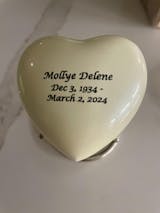Different Urn Materials
Cremation is quickly becoming the most requested final form of disposition in America. Choosing an urn can be quite confusing if you don’t know what kind of material is most appropriate for storage, scattering, or burial. There are many different urn materials to choose from, and this guide will provide insight into each material that is available to you.
Different Urn Materials
In alphabetical order, we have outlined the many materials and metals that are used to make cremation urns. An urn is traditionally made from only one material, but there are specialty urns made from a combination of materials.
Aluminum: The second most widely used metal in the world, because it is lightweight, malleable, nonmagnetic, and resistant to corrosion. Aluminum is also available in a wide range of finishing options.
Biodegradable: Eco-friendly urns that are constructed from handmade paper, recycled paper, Himalayan salt, sand, gelatin, cornstarch, or other plant-based materials that can be placed in water or buried in the earth.
Brass: A lightweight metal alloy comprised of copper and zinc for a bright gold appearance. Brass is often combined with bronze or pewter for added strength or a different hue.
Ceramic: A delicate material made of clay that’s hardened by heat. Ceramic urns can also be made of porcelain and mudstone for an earthy appearance.
Copper: A lightweight, malleable material that is naturally reddish-brown in color and resistant to corrosion. Copper wire is popularly used to make cloisonné urns. Oxygen can result in a blueish-green layer of copper oxide over time.
Enamel: An opaque or semitransparent glassy substance that is usually applied to metallic or hard surfaces as an ornamentation or protective coating. Available in a wide array of colors.
Glass: Some people use ash-infused glass to create urns for their loved ones.
Marble: A natural material that is quarried throughout the world. Marble is primarily formed from limestone, which has been crystallized over millions of years. Beloved for its swirling pattern. Cultured marble is an affordable alternative.
Medium Density Fiberboard: MDF is an engineered wood product made by breaking down hardwood or softwood residuals into wood fibers. MDF urns are an inexpensive alternative to wood cremation urns.
Pewter: A metal alloy comprised of copper and antimony, otherwise known as tin and lead. Pewter urns have a bright and glossy appearance. Over time, the metal can oxidize and acquire a grayish tint. Pewter is often plated over brass.
Serpentine: A dark green mineral found in serpentinite rocks that’s also known as “New Jade.” Serpentine urns have a lovely light green shade with white marbling and a lustrous exterior that is soft to the touch.
Soapstone: A metamorphic rock that has been quarried for millennia. Soapstone is primarily composed of talc, which is very easy to carve. Soapstone urns are nonporous and resistant to heat.
Wood: Cherry, maple, pine, oak, walnut, and poplar are the most popular materials used to make wood urns. Wood urns and memory boxes can be stained or adorned with inlays, appliques, and laser etchings.
We hope that this guide to the many different urn materials provides the insight you need to make the best decision for yourself or a loved one. If you have any questions about these materials or would like to learn more about the urns available at OneWorld Memorials, please contact us today so that we may be of assistance during this difficult time.

